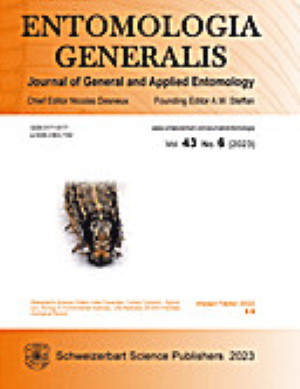Chilonis Trichogramma 是一种很有前途的生物防治剂,可在中国防治 Tuta absoluta:实验室和温室试验的结果
IF 4.6
1区 农林科学
Q1 ENTOMOLOGY
引用次数: 0
摘要
Tuta absoluta 是一种威胁全球番茄作物生产的重要经济害虫,最近已入侵中国。由于杀虫剂的抗药性,需要在害虫综合治理(IPM)计划中采用替代控制方案。在新入侵地区,利用本地天敌进行生物防治是一种很有前景的防治方法。本研究在实验室条件下评估了中国四种商品化的毛翅目寄生虫(T. dendrolimi、T. japonicum、T. chilonis 和 T. ostriniae)对 T. absoluta 卵的寄主适宜性。在温室实验中,我们还进一步测试了最有希望的蝽种在不同释放密度和频率下的防治效果。我们发现,T. chilonis是最有希望寄生于T. absoluta卵的种类,其寄生率、出虫率和雌性后代性别比均最高。温室实验表明,60 万只寄生蜂/公顷(20 只寄生蜂/植株)是最有效的释放密度,防治效果达到 76%。释放频率对温室中的寄生率影响很大。在第 1 天和第 4 天释放两次每公顷 30 万只寄生虫是最有效的策略,而在第 1 天释放一次每公顷 60 万只寄生虫则是最无效的策略。我们的研究结果表明,在中国用本地的Trichogramma寄生虫T. Chilonis来加强对T. absoluta的生物防治是可行的,可以将其作为中国防治T. absoluta的IPM方案的一部分。本文章由计算机程序翻译,如有差异,请以英文原文为准。
Trichogramma chilonis is a promising biocontrol agent against Tuta absoluta in China: results from laboratory and greenhouse experiments
Tuta absoluta, an economically important pest threatening the global production of tomato crops worldwide, has recently invaded China. Owing to insecticide resistance, alternative control options are needed within the context of integrated pest management (IPM) programs. Augmentative biological control using indigenous natural enemies is a promising tactic for managing T. absoluta in newly invaded areas. In this study, the host suitability of four commercialized Trichogramma parasitoids in China (T. dendrolimi, T. japonicum, T. chilonis, and T. ostriniae) on T. absoluta eggs was evaluated in laboratory conditions. The control effectiveness of the most promising Trichogramma species was further tested at different release densities and frequencies in a greenhouse experiment. We found that T. chilonis was the most promising species parasitizing T. absoluta eggs, showing the highest parasitism rate, emergence rate, and female offspring sex ratio. The greenhouse experiment indicated that 600,000 parasitoids/hectare (20 parasitoids/plant) was the most effective release density, reaching 76% control effectiveness. Release frequency significantly affected the parasitism rate in the greenhouse. Two releases of 300,000 parasitoids/hectare on Day 1 and Day 4 was the most effective strategy, compared to one release of 600,000 parasitoids/hectare on Day 1. Our findings showed that augmentative biological control of T. absoluta by native Trichogramma parasitoids T. chilonis in China is feasible, and it could be included as part of IPM package against T. absoluta in China.
求助全文
通过发布文献求助,成功后即可免费获取论文全文。
去求助
来源期刊

Entomologia Generalis
生物-昆虫学
CiteScore
7.10
自引率
18.80%
发文量
72
审稿时长
>12 weeks
期刊介绍:
Its scope covers all aspects of basic and applied research dealing with insects and more broadly with arthropods inhabiting wild, agricultural and/or urban habitats. The journal also considers research integrating various disciplines and issues within the broad field of entomology and ecology.
Entomologia Generalis publishes high quality research articles on advances in knowledge on the ecology and biology of arthropods, as well as on their importance for key ecosystems services, e.g. as biological control and pollination. The journal devotes special attention to contributions providing significant advances (i) on the fundamental knowledge and on sustainable control strategies of arthropod pests (including of stored products) and vectors of diseases, (ii) on the biology and ecology of beneficial arthropods, (iii) on the spread and impact of invasive pests, and (iv) on potential side effects of pest management methods.
Entomologia Generalis welcomes review articles on significant developments in the field of entomology. These are usually invited by the editorial board, but proposals may be sent to the Editor-in-Chief for preliminary assessment by the editorial board before formal submission to the journal. The journal also considers comments on papers published in Entomologia Generalis, as well as short notes on topics that are of broader interest.
 求助内容:
求助内容: 应助结果提醒方式:
应助结果提醒方式:


